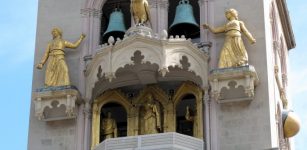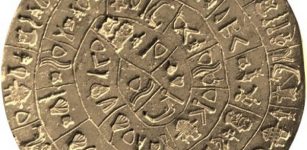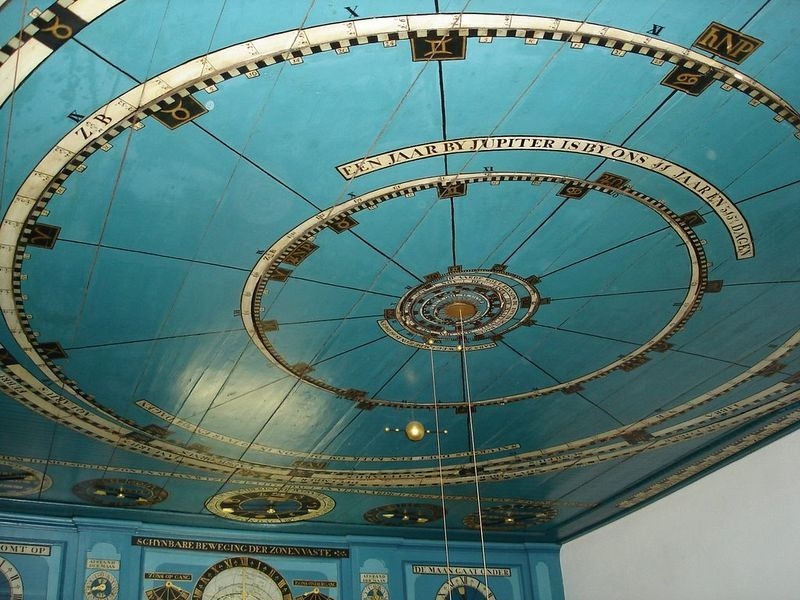Inside Eisinga Planetarium – World’s Oldest Working Planetarium – Built To Stop Doomsday Prophecies
Ellen Lloyd – MessageToEagle.com – Our fascination with the beautiful and mysterious Universe stretches far back in time. Our ancestors marveled at the night sky and observed moving celestial objects a long time ago.
Astronomy is the oldest of the natural sciences, dating back to antiquity, with its origins in the religious, mythological, cosmological, calendrical, and astrological beliefs and practices of pre-history.
Unfortunately, sometimes the movements of celestial objects were interpreted in an unscientific manner based on superstition. This often resulted in horrible and frightening doomsday prophecies that of course never came true.
Eisinga’s planetarium was built to stop doomsday prophecies
One man was determined to disprove a contemporary prophecy that certain planets were on a collision course and that the end of the world was therefore imminent. His name was Eise Eisinga. He was Frisian wool-comber and he was not a scientist in the formal sense, but a creative genius who built a marvelous working planetarium entirely on his own initiative. Although it should be added Eisinga mastered mathematics and astronomy more than well.
Image credit: James Stringer
Eisinga’s planetarium was built at a time when the nation was gripped by panic and hysteria. It started with a small book published in 1774 by a Dutch preacher named Eelco Alta, from the Frisian village of Bozum, in which he made a clichéd yet terrifying prediction — the end of the earth. Earlier, astronomers had announced that unusual conjunction of the moon and the planets Mercury, Venus, Mars, and Jupiter was to happen on 8 May, 1774. Alta argued that on this very day, the planets and their moon would collide, with the result that the earth would be propelled out of its orbit and burned by the sun.
See also:
Auroville – A City Free From Politics, Money And Religion
Astonishing ‘Cathedral’ Built By Termites Reminds Of Gaudi’s Barcelona Masterpiece
The purpose behind Eisinga’s planetarium was that he could demonstrate that the planets were actually in conjunction and there was no reason for panic.
The planetarium constructed by Eisinga is still working
Between 1774 and 1781, Eisinga constructed his planetarium in his Franeker, Netherlands.
Image credit: Rapsak
In order to fit it into his living-room, he used a scale of 1:1,000,000,000,000 (1 millimeter: 1 million kilometers). The Eisinga Planetarium “hangs” from the ceiling — a golden orb, somewhat larger than a baseball, represents the sun and descends from the middle of the ceiling, with a number of other smaller orbs, representing the planets, rest in concentric grooves around the sun. A pendulum clock and a series of intricate mechanical gears, which Eisinga fashioned with his own hand, drives the planets at the precise rate they do in our solar system.
Image credit: Ciska van Geer
Eisinga expected to finish the planetarium within six months, but it took him seven long years. He eventually completed it in 1781. The Eisinga Planetarium received a lot of visitors when it opened. When King William I visited the planetarium in 1818, he was so impressed that he subsequently bought it for the Dutch state.
Image credit: John Groen
Eisinga died in 1828, after which his son took over the running of the planetarium. The Eisinga family continued to run the planetarium until 1922.
The planetarium is still in full working order and is completely intact, with regard to both form and materials. Maintenance is still carried out according to Eise Eisinga’s own and it’s run by curators appointed by the city of Franeker.
If you are in the neighborhood, make sure to stop by and see it!
Written by Ellen Lloyd – MessageToEagle.com
Copyright © MessageToEagle.com & Ellen Lloyd All rights reserved. This material may not be published, broadcast, rewritten or redistributed in whole or part without the express written permission of MessageToEagle.com and Ellen Lloyd
Expand for referencesRelated Posts
-
 End The Amazon Forest Apocalypse – Sign The Petition!
No Comments | Aug 23, 2019
End The Amazon Forest Apocalypse – Sign The Petition!
No Comments | Aug 23, 2019 -
 Unraveling The Mystery Behind The Perplexing Story Of Pied Piper Of Hamelin
No Comments | Sep 29, 2015
Unraveling The Mystery Behind The Perplexing Story Of Pied Piper Of Hamelin
No Comments | Sep 29, 2015 -
 Kyaiktiyo Pagoda Built On Huge Granite Boulder That Seems To Defy Gravity
No Comments | Mar 25, 2017
Kyaiktiyo Pagoda Built On Huge Granite Boulder That Seems To Defy Gravity
No Comments | Mar 25, 2017 -
 Our Universe Is A Gigantic And Wonderfully Detailed Holographic Illusion
No Comments | Aug 5, 2015
Our Universe Is A Gigantic And Wonderfully Detailed Holographic Illusion
No Comments | Aug 5, 2015 -
 Messina Cathedral And Its Automated Astronomical Clock Tower
No Comments | Jan 14, 2016
Messina Cathedral And Its Automated Astronomical Clock Tower
No Comments | Jan 14, 2016 -
 Mysterious Mount Roraima Rising Over 8000 Feet Into The Clouds
No Comments | Sep 15, 2015
Mysterious Mount Roraima Rising Over 8000 Feet Into The Clouds
No Comments | Sep 15, 2015 -
 Controversial Artifact: What Kind Of Message Does The Phaistos Disk Contain?
No Comments | May 13, 2014
Controversial Artifact: What Kind Of Message Does The Phaistos Disk Contain?
No Comments | May 13, 2014 -
 Meet The Blob – One Of Nature’s Most Mysterious Organisms
No Comments | Oct 19, 2019
Meet The Blob – One Of Nature’s Most Mysterious Organisms
No Comments | Oct 19, 2019 -
 Mythical Beautiful Adarna Bird And Its Harmful Magical Power In Mythology Of Philippines
No Comments | Jan 25, 2017
Mythical Beautiful Adarna Bird And Its Harmful Magical Power In Mythology Of Philippines
No Comments | Jan 25, 2017 -
 Amazing Phenomenon Of Singing Plants
No Comments | May 10, 2012
Amazing Phenomenon Of Singing Plants
No Comments | May 10, 2012




